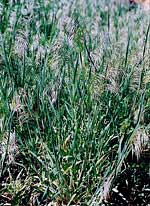The Western U.S. has many well-known problems — overgrazing, rampant development, Garth Brooks look-alikes. But one troublesome issue that hasn’t gotten much attention is cheatgrass, an exotic weed that arrived here in the 1890s and has since taken over an area the size of Montana.

Cheatgrass never prospers?
Photo: Russel Stevens/Chuck
Coffey, Noble Foundation.
Because cheatgrass (aka: downy brome, junegrass, and broncograss — it’s the stuff that gets stuck in your socks when you walk in the desert) provides some forage early in the spring, most ranchers haven’t recognized it as a significant threat. But the problem is that cheatgrass, while flammable, tolerates fire beautifully. Native shrub lands don’t. So when cheatgrass infiltrates an area, often after a long history of abusive grazing, it’s only a matter of time until the native plants are turned to charred embers and a cheatgrass desert has sprung up in their wake. Cheatgrass, in turn, paves the way for worse weeds — knapweed and jointed goatgrass, which are inedible and difficult to eradicate.
There aren’t many soldiers in the war against cheatgrass. A handful of them are sequestered near the campus of Brigham Young University in Provo, Utah, in a nondescript building that houses the USDA Forest Service Shrub Lab. There, ecologist Susan Meyer and colleagues have spent the last three years trying to develop a cheatgrass biocontrol method using a fungus called a “smut” that renders cheatgrass sterile.

Susan Meyer, crusader against
cheatgrass.
Photo: Lisa Jones.
“The good thing about this disease is it’s already out there,” Meyer says of smut. “But different strains of cheatgrass take turns being infected, because they are susceptible to different strains of smut. It’s very hard to get an epidemic because there’s this dynamic equilibrium going on.” Her job, which she started three years ago, is to come up with a blend of smut strains that can attack all strains of cheatgrass at once.
The Spore the Merrier
Smut takes over the reproductive apparatus of a cheatgrass plant, which then stops producing seeds and starts producing knobs made of black powder called smut bullae.
“All that comes out is spores!” says Meyer. “I’m really psyched up about this stuff. Smut spores germinate along with the seeds of cheatgrass plants that escaped infection. It’s very important that their germination matches the germination of the seed. We know more about when cheatgrass germinates than anyone in the world.”
But the battle isn’t won yet. “Whether we can get full infection in the field remains to be seen,” she says. “There are certain variables that can interfere. Cheatgrass can come up at different times in the season, depending on the available moisture. The smut has to germinate at the same time. For instance, some cheatgrass is coming up now [January], and winter’s not good for smut germination.”
Such obstacles won’t be surmounted a moment too soon, says Meyer. “I think [cheatgrass] could easily be the death of natural ecosystems in the Intermountain West,” says Meyer, who got her PhD in botany from Claremont Graduate School near Los Angeles. “People just don’t know that low-elevation ecosystems are going down the tubes. We’re already talking 40 million hectares [about 100 million acres] in the West where cheatgrass is the dominant grass species.
“We have these fires and people don’t know that’s why it’s happening. People just don’t have a clue. I didn’t have a clue. I was trained as an ecologist in another part of the country and I came here and it was like, ‘Where’s the desert? It’s gone.'”
Meyer is a self-described radical environmentalist, but because she lives in “a very conservative place,” she tempers herself. “If you actually want to change people’s hearts, you can’t do it by being adversarial. I just inculcate my values into people. I don’t say, ‘I hate cows.’ I say, ‘I love native plants.'” And she hopes the locals will come around someday.


